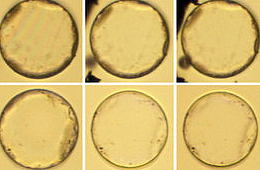Research Abstract
ヘリウムがシリカガラスに浸透して圧縮性を減少させる
SiO2ガラスはネットワーク構造を持ち、構造中にかなりの量の格子間空隙を含んでいる。ケイ酸塩へのガスの溶解度は、高圧下では空隙が収縮するために小さくなると予想されてきた。
Helium penetrates into silica glass and reduces its compressibility
2011年6月14日 Nature Communications 2 : 345 doi: 10.1038/ncomms1343

SiO2ガラスはネットワーク構造を持ち、構造中にかなりの量の格子間空隙を含んでいる。ケイ酸塩へのガスの溶解度は、高圧下では空隙が収縮するために小さくなると予想されてきた。本論文では、ヘリウム中でのSiO2ガラスの異常な振る舞いについて示す。体積測定によって、ヘリウム中では、SiO2ガラスは通常よりも圧縮されにくく、10 GPaでのヘリウム中の体積は2 GPaでの通常の体積に近いことが明らかになった。X線回折とラマン散乱の測定は、ヘリウムが空隙に浸透するために、ヘリウム中では空隙の収縮が妨げられていることを示唆する。推定されるヘリウムの溶解度は非常に高く、10 GPaにおいてSiO2ガラス1モル当たり1.0から2.3モルである。この値は、従来のモデルとは全く異なっている。これらの結果は、地球進化についての議論だけでなく、さまざまな高圧実験の解釈に影響を与え、新材料の創造にもつながる可能性がある。
- 東京大学物性研究所
- 東京大学大学院理学系研究科
SiO2 glass has a network structure with a significant amount of interstitial voids. Gas solubilities in silicates are expected to become small under high pressure due to compaction of voids. Here we show anomalous behaviour of SiO2 glass in helium. Volume measurements clarify that SiO2 glass is much less compressible than normal when compressed in helium, and the volume in helium at 10 GPa is close to the normal volume at 2 GPa. X-ray diffraction and Raman scattering measurements suggest that voids are prevented from contracting when compressed in helium because helium penetrates into them. The estimated helium solubility is very high and is between 1.0 and 2.3 mol per mole of SiO2 glass at 10 GPa, which shows marked contrast with previous models. These results may have implications for discussions of the Earth’s evolution as well as interpretations of various high-pressure experiments, and also lead to the creation of new materials.

